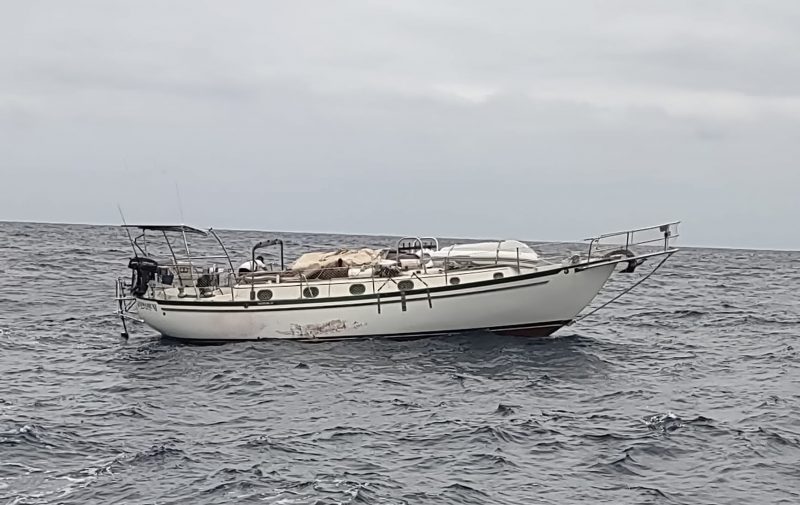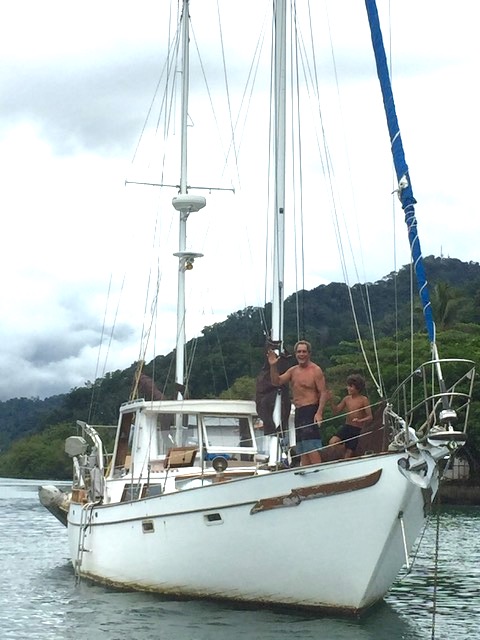
What’s Going On in the Pacific? — A Season of Life-threatening Incidents
This week we received a letter from Latitude 38 editor-at-large and Pacific Puddle Jump honcho Andy Turpin about the recent spate of maritime incidents in the Pacific. His letter also raised some questions of our own.
As reported in this forum and elsewhere, there has been an unusually high number of life-threatening incidents in the Pacific this year. First there was the dismasting of the Westsail 43 Niniwahuni, 950 miles west of Mexico, whose family crew was aided and evacuated, apart from the skipper. [The skipper stayed aboard to try to save the boat, which he eventually did.]

Next, the Peterson 44 Raindancer collided with a whale and sank 15 minutes later, leaving four crew adrift in a liferaft and inflatable. [All were successfully rescued by the catamaran Rolling Stones, which was able to divert to their position ahead of any other vessels.] Similarly, we are told that recently a large Danish catamaran collided with a whale somewhere west of Panama and sank in less than an hour; all crew were rescued. [Eight sailors were rescued in the Pacific on Wednesday after a collision with a whale caused their boat to capsize. They were picked up by a fishing boat, then transferred to a container ship headed for Tahiti.]
Roughly 650 miles from making landfall in the Marquesas, the Catalina 470 Lucky Dog lost her rudder, after which her two crew were safely evacuated to Hiva Oa aboard the Hylas 46 Beleza.
Weeks later, concern for the Island Trader 45 Yasukole spread when her position reports stopped abruptly. At the same time, a solo adventurer attempting to row around the world was in a desperate situation, adrift in a tiny liferaft with virtually no means to communicate, after his rowboat and her onboard systems had been badly damaged by rough seas. Amazingly, US Coast Guard assets who were searching for Yasukole serendipitously found the solo rower, although they found no signs of Yasukole. She eventually turned up in American Samoa, with her father-and-son crew reporting no major problems, just a very slow trip (78 days from La Paz to Pago Pago).
And this week we learn the story of Australian sailor Tim Shaddock and his dog Bella, who endured three months, mostly adrift, aboard their 30-ft (x 14-ft) Wharram catamaran Aloha Toa, before being rescued this week by Mexican fishermen, 1,200 miles offshore. Apparently it was pure luck that the fishing boat’s helicopter crew spotted the disabled cat — and was possibly their only chance for survival. Believe it or not, Aloha Toa had registered with the Pacific Puddle Jump, but Shaddock’s entry data shows that his boat’s only offshore communications device is a VHF radio. No HF radio, satphone, inReach, Iridium GO!, etc. Also, no EPIRB or PLB. No MMSI number. And no liferaft. Our only way to reach him in order to clarify his info was via his email address, to which he did not respond. He never once checked in with us, as requested, but apparently he had no means to do so.

The Pacific Puddle Jump has always had an inclusive attitude toward singlehanders, and we have always respected the desire of some sailors not to check in regularly due to privacy concerns. But we do feel strongly that every offshore cruiser should carry a properly registered EPIRB. If you have strong feelings about singlehanding or check-in requirements, this is a good place to express them.
In any case, we were thrilled to learn that Tim and Bella are alive and well, and we wish them the best of luck with whatever comes next.
— Andy Turpin, PPJ.
While researching the story about Australian sailor Tim Shaddock earlier this week, we came across an interview during which he told the reporter that he had a Garmin inReach, and would use this device each day to check in with his family in Australia. “I’ve been in good communication with the family, you know, through all this and while I was out there.” Why did he not call for help? Why did he register with the PPJ yet not list his inReach, or respond to any check-in calls?
Latitude has always understood that many folks sail for freedom and escape, though we also believe mariners have the responsibility to think of others when making their choices and for learning and practicing the best seamanship possible. With almost 50 years of stories covering what has and could go wrong at sea we hope to help folks avoid similar problems. The Baja Ha-Ha, Pacific Puddle Jump and other rallies take pains to explain risks, encourage education and discussion around communications, work with the Coast Guard, organize and publicize seminars to help everyone goes to sea with eyes wide open and prepared to deal with whatever comes their way. These efforts won’t prevent all dreamers from casting off unprepared, though we join all in making sure the information is as available as possible. Of course, many of these folks sail off and manage just fine, while others head off, never imagining the microscope of social judgment will suddenly be focused on them if they get in trouble. For them, it can be like getting caught with your hand in the cookie jar.
There is room for conflict between the idea of a sailor happily drifting along and the people who are worried for them and, in the event of a call for help, those who are sent to enact a rescue. Take for example, the captain, Don, aboard Ishi, another sailboat that has been reported missing in the Pacific. According to a friend of Don’s, a reader named Brian, Don would prefer that the authorities not be alerted should anyone be concerned as to his whereabouts. “We have talked about this many times,” Brian wrote, “and he always said if he ever went missing, to never call the Coast Guard on him because all that does is end up creating more regulations for all of us boaters, from the more people that have problems and call the Coast Guard. If he doesn’t want to be found that’s his choice.” Like everyone, we want all to be safe but also ask, are we all becoming the helicopter parents of every cruiser’s decision?
This perspective brings up the question, “When does someone have the right to just ‘disappear’ and not be rescued?” U.S. Code Title 46, Chapter 23, §2304, “Duty to provide assistance at sea,” states:
(a)(1) A master or individual in charge of a vessel shall render assistance to any individual found at sea in danger of being lost, so far as the master or individual in charge can do so without serious danger to the master’s or individual’s vessel or individuals on board.
(2) Paragraph (1) does not apply to a vessel of war or a vessel owned by the United States Government appropriated only to a public service.
(b) A master or individual violating this section shall be fined not more than $1,000, imprisoned for not more than 2 years, or both.”
Interesting to read. But who determines “any individual found at sea in danger of being lost?” What happens if the master of the vessel determines that a sailor is in danger, if the sailor is happy with their situation, regardless of any potential danger to themselves? Was Timothy Shaddock happy just drifting along, and therefore didn’t call for help? Is Ishi just drifting along, wishing they could be helped? We presume most mariners would want to be rescued should the need arise. Perhaps there could be a “Do not rescue” register. But then again, even if there were, would anyone sign up for that?

The 2 gals aboard SV Sea Nymph come to mind… Only until they took a tow from a fishing boat did they ever feel the need to be rescued.
Yes, live and let live… A more important question is why so many collisions with whales??? I fear that and underwater debris sinking my solo sailer!!!
I’ve often noticed it’s the loudest, rather than the most open-minded, people who dominate a conversation and shape policy. It’s enough to drive someone to sea. Were I having a face-to-face conversation with an intelligent mariner, who I respected, over a cup of tea, I would have plenty to say. But a public, online forum I won’t touch with a 10-foot spinnaker pole.
I am baffled by the purported comment that someone doesn’t want to be rescued by the USCG because “it will create more regulations”. Coast Guard rescuers are heroes and take pride in their rescues. Thankfully, the Coast Guard also takes a dim view of unprepared people setting sail in unseaworthy craft. We are lucky to have them at our side. They are counselors and allies, not something to be avoided.